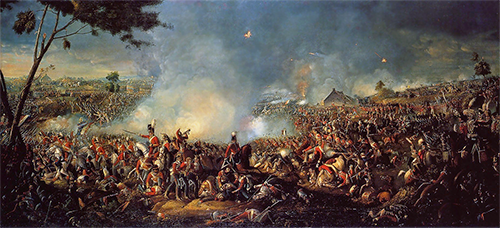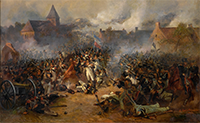The Battle of Waterloo
Part 2: The Battle and Aftermath On June 18, Bonaparte had a plan of attack but, because of the soaked earth and fearing that his infantry and especially the artillery might get bogged down in the mud, waited until nearly noon to implement it. The first aim of the French attack was to seize control of the château at Hougoumont, which was much closer to the French position than to the Allied army. That maneuver was intended to be a diversion, but it turned into a diverting thicket of struggle for both forces. For nearly 90 minutes, the château encompassed the entirety of the fighting. By the time that the main French attack was under way, a Prussian corps of 30,000 under Friedrich Wilhelm, Freiherr von Bülow had arrived and joined the fray. The main Prussian army wasn't far behind. Bonaparte hurriedly sent a dispatch to Grouchy, imploring him to return; the marshal, however, had found a Prussian force and could not break off that engagement. The French attack continued. After a huge artillery barrage, Ney and a force of 18,000 infantry smashed into the Allied center. A counterattack by Wellington's cavalry was successful at scattering the French attack, forcing a withdrawal from Papelotte. 
At mid-afternoon, the fighting at Hougoumont still raged. Wellington, during the course of the day, poured 12,000 troops into the battle for the cháteau. In desperation, Bonaparte ordered it set on fire. He also ordered Ney to take La Haye Sainte so a major assault, incorporating the Imperial Guard, could commence. Ney ordered the cavalry into action, and three divisions advanced against what they thought were retreating infantry. Instead, Wellington's men formed into Infantry Squares. The French attack force was entirely cavalry and so had no support from artillery or infantry; the defenders, by forming into their squares, could effectively concentrate their fire on the attacking horses. (Bonaparte had successfully deployed this formation as part of his victory over the Mameluks at the Battle of the Pyramids in 1798.) Because of the fighting on the flanks, the cavalry was forced into a narrow line of attack and so Infantry Squares could maximize their position. As the cavalry bore down on the infantry, the Prussians arrived and jumped into the conflict. After marching for 11 hours, the Prussians, at 4:30 p.m., hit the ground running. Grouchy had gotten a late start in his pursuit of the Prussians and, as a result, had not been entirely sure where they had gone; as a result, he was not able to keep them from getting to Wavre, from which they could easily go to Waterloo. The cavalry attacks continued, while the French infantry waited. At 6 p.m., once the cavalry attacks had stopped, the infantry waded in and finally captured La Haye Sainte. The French hurriedly got their big guns into position there and started pounding the Allied center. At this point, two more Prussian corps arrived and joined the battle. 
Bonaparte had made a habit of saving his Imperial Guard infantry as reserves. At 7:30 p.m., he sent them in. The initial advance was a strong one, as the rest of the French forces augmented the attacks and counterattacks of the vaunted Imperial Guard, theretofore undefeated in battle. It appeared for a time as if the Imperial Guard was going to have its way with the Allied defenders. A timely intervention by Dutch forces under David Hendrik Chassé saved the day for Wellington and the Allies. Their combination of infantry, horse, and artillery was so devastating that it drove the Imperial Guard backward. The Guard rallied and set about their business again but were again undone, this time by a bayonet charge, again by the Dutch. A final charge by an infantry regiment from the U.K. put the Imperial Guard to flight and convinced Bonaparte to order a general retreat and depart the field of battle. The attempted retreat was as chaotic as the fighting earlier had been, and many French soldiers ended up as prisoners. French overall casualties were 41,000, of which 15,000 were missing and presumed dead, 7,000 were captured, and the rest were killed or injured in action. Allied casualties numbered 24,000, including 4,700 killed in action, 14,600 injured, and 4,700 missing and presumed dead. Bonaparte abdicated for a second time, on June 24. Allied armies entered Paris on July 7, having fought their way through a few contingents of French troops on their way there. The following day, Louis XVIII returned and again took the throne. Bonaparte, meanwhile, surrendered himself, on July 15, and was sent to the U.K. (He was later sent for a second exile to St. Helena, an even more remote island than Elba. He died there in May 1821.) First page > The Prelude > Page 1, 2 |
|
Social Studies for Kids
copyright 2002–2026
David White




